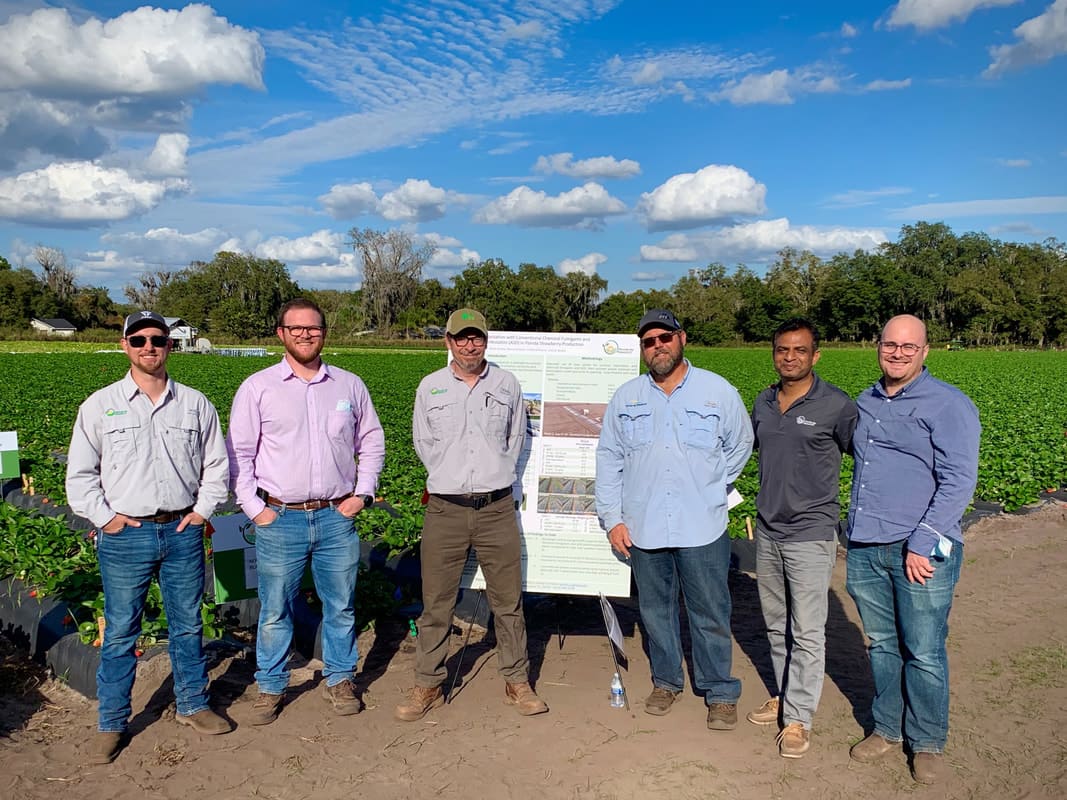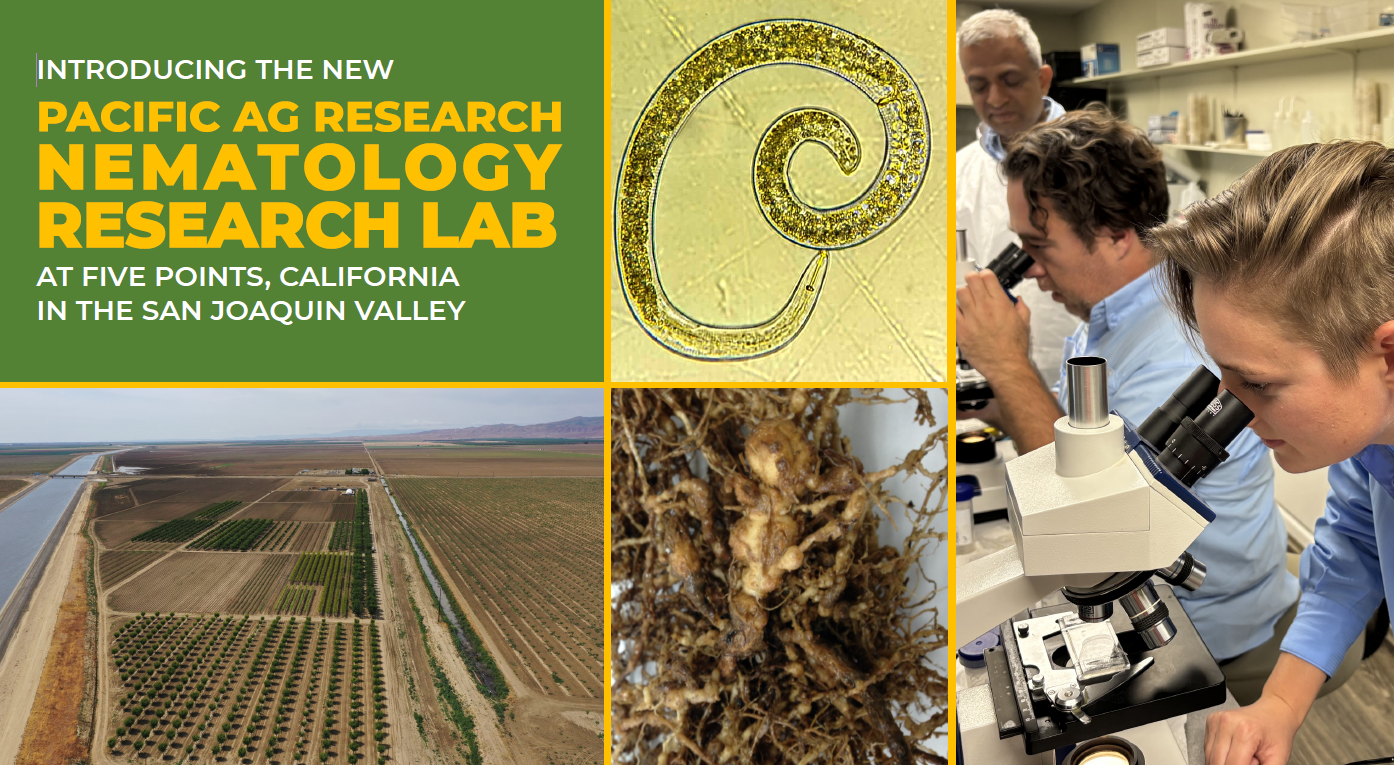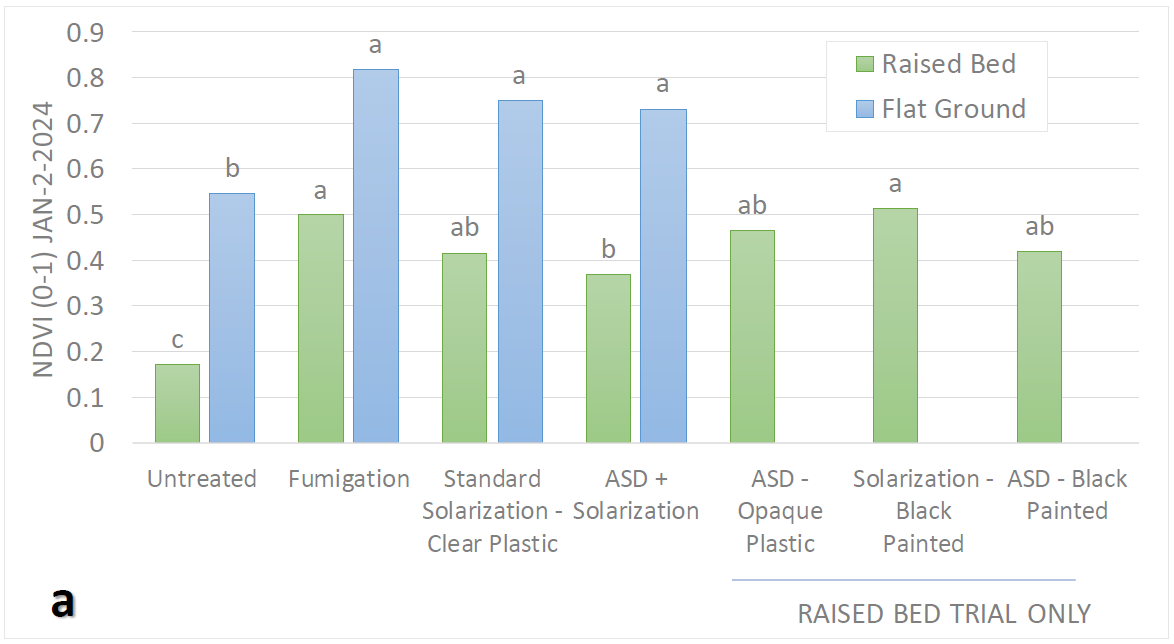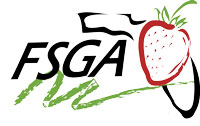New Pacific Ag Research Nematology Research Lab in Five Points, CA in the San Joaquin Valley4/25/2024
F.V. Sances (1), B. Aglave (1), K. Williams (1), C. Boone(1), B. Booker (2), W. Schonborn (3), & E. Rosskopf (3) (1) Florida Ag Research, (2) Ag Metrics Group, (3) US Department of Agriculture (Collaboration Only)
Here, we build on previous work from these and other researchers to develop site-specific “Best Practices” for alternative nematode and pathogenic soil fungi control for Central Florida. Two summer solarization trials took place at the Dover Lab and yields for ASD + Solarization were on par with fumigation. This season we increased precision of applications for manure and molasses and included raised beds or flat ground comparisons.
Flat Ground: In many commercial settings, ASD and Solarization treatments are easier accomplished on flat ground. Here, the chicken manure was applied to the treated area utilizing a cone spreader, followed by mechanical injection of molasses, then the area was disked and plastic mulched. Methodology
Raised Bed: Planting beds were inoculated with soil-borne diseases, Sting nematodes, and common weed seeds before treatment. Four replicates of five treatments were randomly placed into planting beds previously farmed in strawberries. Following summer solarization/ASD, beds were formed in September (Fumigated) and in October, half of the ASD and Solarization plots with clear plastic were painted black. Flat Ground: Bare ground areas were inoculated with soil-borne diseases, Sting nematodes, and common weed seeds before treatment. Four replicates of four treatments were placed into previously farmed strawberry ground. Each plot comprises one planted bed 120 ft in length. Following summer solarization and ASD plots, beds were formed in September. Crop Health Yields Cumulative Yield data for approximately 6 weeks of harvests at the raised bed (a) and flat ground (b) fields, compared to cumulative annual yield from the previous years’ study at Dover (c) and the Duette, FL, grower site that was a flat ground treatment (d). Summary: Management of soil borne pests on commercial Florida strawberry farms has long been a challenge to growers. In recent years, this has been particularly difficult with regulatory pressures on the use of remaining chemical soil fumigants and the costs associated with their use. Also, while still in its infancy, organic strawberry production in Florida has been established by several shippers to try to meet the demand for this strawberry market segment. To provide growers with alternative non-fumigant soil pest management techniques, this project builds on previous work from these and other researchers with an on-site demonstration of Soil Solarization and Anaerobic Soil Disinfestation for the 2023 grower outreach by our collaborative groups. Click Poster to Download
Frank Sances will be attending the 2022 MBAO: Fumigation and Alternatives for Production, Storage and Trade Conference in Orlando. Come find out about our "Efficacy of Solarization and Anaerobic Soil Disinfestation" study. Email us to have a meet-up or a pre- or post-conference tour of our Florida Station, less than 2 hours from Orlando. #anaerobicdisinfestation #strawberry #MBAO #Methylbromide #FloridaAg #FloridaAgResearch [email protected]
Florida Ag Research presented a “Proof of Concept” field demonstration intended to evaluate the suitability of using solar radiation to enhance soil borne pest control with Conventional Fumigants and Anaerobic Soil Disinfestation in commercial Florida strawberry production. Potential benefits of the system include: a) Solarization and ASD are approved organic soil pest control options b) Solarization with conventional soil borne pest control inputs may allow reduction in chemical usage c) ASD is a potential waste recycling system The project, which began in June of 2021, was published by Florida Ag Research/Ag Metrics Group scientists and growers: Frank Sances, Balaji Aglave, Mark Keeley, Kaleb Williams, and Charlie Boone. The Solarization Project was presented by Ag Metrics Group’s Mark Keeley (formerly a Station Manager of Florida Ag Research). “It was great to come back out and present this exciting work to growers and researchers since the ‘Field Day’ was cancelled last January,” said Keeley, “And a great opportunity to introduce Mariano [Galla], the new Florida Ag Research Station Manager, to the Florida strawberry grower community.”  L to R: Florida Ag Research / Ag Metrics Group Project Team: Kaleb Williams - Field Operations, Mark Keeley - Special Projects, Brad Booker - Pacific Ag Research Station Manager (former Florida Ag Research Station Manager), Charlie Boone - Assistant Station Manager, Balaji Aglave - Nematology / Plant Pathology, Mariano Galla - Station Manager |
Archives
April 2024
Categories
All
|




























 RSS Feed
RSS Feed
